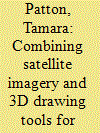| Srl | Item |
| 1 |
ID:
115972


|
|
|
|
|
| Publication |
2012.
|
| Summary/Abstract |
The ability to extract three-dimensional (3D) data from two-dimensional satellite images provides opportunities to apply novel geospatial techniques to problems relating to nuclear arms control, nonproliferation, and disarmament. This study demonstrates some of these techniques by estimating the plutonium production capacity of the heavy water nuclear reactors at the Khushab complex in Pakistan, where since 1998 Pakistan has produced plutonium for its nuclear arsenal. Three-dimensional analysis is used to assess the viability of using the horizontal cross-sectional area of the Khushab reactors' mechanical draft cooling towers to estimate the thermal capacity of each reactor and set an upper bound for the reactors' abilities to produce plutonium. The horizontal area approach suggests the three completed Khushab reactors have a thermal power of 40-90 MWt each. The results suggest that a horizontal area approach can be used successfully with the Khushab reactors, as well as other low power, research-type reactors employing mechanical draft cooling towers.
|
|
|
|
|
|
|
|
|
|
|
|
|
|
|
|
| 2 |
ID:
115970


|
|
|
|
|
| Publication |
2012.
|
| Summary/Abstract |
This article assesses the feasibility and benefits of converting the Iranian heavy water research reactor, IR-40, from using natural uranium to low-enriched uranium fuel. Based on neutronics calculations for a detailed model of the two reactor configurations, a conversion would result in a smaller core with a subsequent reduction and degradation of plutonium production. It is argued that the proposed conversion will provide Iran with a research reactor that is better suited for scientific experiments and radioisotope production than in its original configuration. It is proposed to introduce the converted IR-40's fuel consumption requirements as a natural cap for Iran's future enrichment efforts.
|
|
|
|
|
|
|
|
|
|
|
|
|
|
|
|
| 3 |
ID:
115969


|
|
|
|
|
| Publication |
2012.
|
| Summary/Abstract |
This article deals with the plutonium production capabilities in civilian research reactors and the resulting proliferation risks. A complete record of all civilian research reactors located in Non-Nuclear Weapon States and de-facto Nuclear Weapon States is compiled and systematized according to their type. A discussion of the various production paths and scenarios for plutonium with those reactors follows. In order to derive an assessment with a broad coverage, partly diverse fleet of reactors, two designs representative of light water and heavy water moderated reactors (which account for 82 percent of the total installed capacity in Non-Nuclear Weapon States and de-facto Nuclear Weapon States) were chosen and included in burn-up calculations with the Monte Carlo code KENO V.a and Origen-S, both incorporated in the modular system Scale-6. The effective production rates in fuel elements as well as by irradiation of targets are then applied to calculate the capabilities of plutonium production of each considered research reactor. The results provide an overview of the proliferation relevance of the global research reactor fleet and its regional distribution.
|
|
|
|
|
|
|
|
|
|
|
|
|
|
|
|
| 4 |
ID:
115973


|
|
|
|
|
| Publication |
2012.
|
| Summary/Abstract |
Converting research reactors from highly enriched uranium (HEU) fuel to more proliferation-resistant low-enriched fuel is critical for achieving the objective of ending the use of directly weapon-usable materials in the civilian nuclear fuel cycle. The most challenging type of reactors to convert are high-flux research reactors, which, along with upcoming strong spallation sources, are the most important neutron sources for sophisticated neutron scattering experiments. Advanced Monte-Carlo computer codes are now available that make it possible to track neutrons from the neutron source, through neutron guides, to the detector of a neutronic experimental setup, including realistic samples. These "virtual experiments" allow optimizing the performance of complete beamlines, where in many cases a large unused potential exists for increasing the neutron flux at the sample or detector position. The Monte-Carlo codes VITESS and McStas are used to compare results for typical neutron scattering setups using typical versus state-of-the-art technologies. The analysis shows that performance gains due to instrument upgrades or neutron guide renewals can dwarf potential neutron flux losses due to conversion to low-enriched fuel. Combined convert-and-upgrade strategies therefore offer unique opportunities for reactor operators and neutron scientists to significantly improve the overall performance of research facilities, and turn them into centers of excellence, while supporting the objective of phasing out the use of highly enriched uranium in the civilian nuclear fuel cycle as soon as possible.
|
|
|
|
|
|
|
|
|
|
|
|
|
|
|
|
| 5 |
ID:
115974


|
|
|
|
|
| Publication |
2012.
|
| Summary/Abstract |
We have attempted to detect seismic signals from small explosions in North Korea on five specific days in 2010 that feature in scenarios proposed by De Geer. We searched the seismic data recorded by station MDJ in northeastern China, applying three-component cross-correlation methods using signals from known explosions as templates. We assess the capability of this method of detection, and of simpler methods, all of which failed to find seismic signals that would be expected if De Geer's scenarios were valid. We conclude that no well-coupled underground explosion above about a ton occurred near the North Korea test site on these five days and that any explosion would have to be very small (local magnitude less than about 2) to escape detection.
|
|
|
|
|
|
|
|
|
|
|
|
|
|
|
|